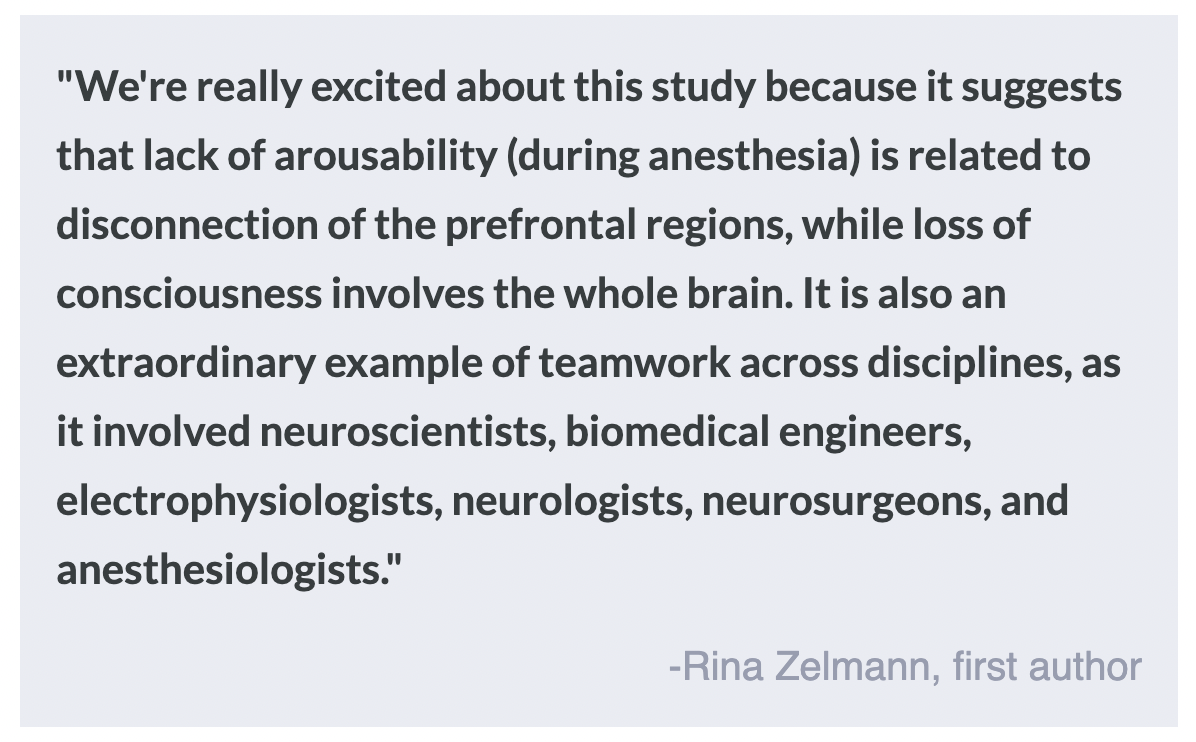Neuronal Network Engagement in the Unconscious Human Brain
Post by Laura Maile
The takeaway
The unconscious brain looks and acts differently from the awake brain. While you are asleep, there is a reduction in complex neural activity and connectivity across the whole brain. While under general anesthesia, however, there is a more pronounced reduction in complex activity and connectivity, which is concentrated in the prefrontal regions of the brain.
What's the science?
Despite decades of research the neural networks and mechanisms underlying consciousness have yet to be agreed upon. Questions remain about whether changes in regional network activation differ between altered states of consciousness. This week in Neuron, Zelmann and colleagues aimed to distinguish the specific neural networks involved in wakefulness versus two distinct types of unconsciousness: natural sleep and general anesthesia.
How did they do it?
In a group of participants with electrodes clinically implanted in the brain to help find the origin of their epileptic seizures, single pulses of electrical stimulation were delivered while recording intracranial electroencephelogram (iEEG) to measure brain activity. This method allowed the authors to measure and analyze cortico-cortical evoked potentials (CCEPs) in response to stimulation, which indicates network connectivity, response variability, and other complex network dynamics. Patients were tested while awake in different environments, during non-REM sleep in the hospital, and while under general anesthesia in the operating room. Various measures were used to compare how complex, connected, and variable the responses were in different states. For instance, the perturbational complexity index (PCI), which measures the complexity of iEEG responses to stimulation, was used to distinguish the functional differences between different levels of consciousness. The PCI value is higher when the region measured has a more complex response to stimulation. These measures of the complexity of brain responses, network connectivity, and variability were compared between unconscious states and different anatomical regions of the brain.
What did they find?
The authors found reduced network connectivity and reduced PCI in both states of unconsciousness compared to consciousness in the same environment. The variability of responses to stimulation was increased in both natural sleep and general anesthesia compared to conscious states. They found decreased cortico-cortical evoked potentials in both unconscious states, but the connectivity and complexity of brain responses were lower in anesthesia conditions than in natural sleep. This means that the brain shows reduced connections when not awake, but that the state of the brain while under anesthesia is distinct from the state while sleeping, demonstrating even less complex activity and connectivity between regions during unarousable conditions. When analyzing differences between anatomical brain regions, they found that the changes in brain activity were uniform throughout the brain during sleep, but were most pronounced in the frontal regions of the brain during anesthesia. The prefrontal cortex showed lower PCI and connectivity when comparing anesthesia to sleep. This means that during anesthesia, the prefrontal cortex is disconnected from other regions of the brain, which is distinct from how the brain functions during sleep.
What's the impact?
This study found that changes in network activity and complexity of brain activity are distinct between different states of unconsciousness, with the prefrontal cortex showing the most dramatic reduction in both measures while under general anesthesia. This work furthers our understanding of the mechanisms of consciousness and the distinct involvement of the prefrontal cortex in arousal. It also demonstrates the therapeutic potential of using direct brain stimulation for recovery of consciousness and in treatments for disorders of consciousness. Future study is needed to understand the specific pathways involved in loss of consciousness and to understand how therapeutics like deep brain stimulation affect sleep and consciousness.


